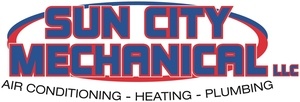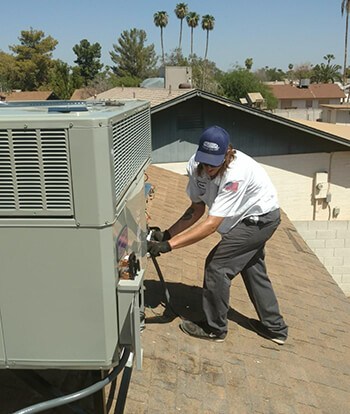If you’re like most homeowners, you rely on your home air conditioning system to keep your family cool on hot summer days. However, many people don’t actually understand how central air conditioning works to cool down the air inside of their homes. By understanding how your AC system works, you can be more effective at not only cooling your home but performing necessary maintenance to keep your system up and running for many years to come.
The Start of the Air Conditioning Cycle
The head of your centralized home air conditioning unit is your in-home thermostat. This thermostat is responsible for reading the ambient temperature of your home and adjusting it via your air conditioning system. During the hot summer months, you may set your air conditioner at a comfortable 78 degrees. If your thermostat reads that your in-home temperature is 80 degrees, it will signal to your air conditioning system to turn on.
As the AC system components turn on, the air handler works to suck air into the venting system. Each room has at least two vents. These are comprised of the supply vent and the return vent. The air handler works to pull air from the return vent into your ductwork for your air conditioning system. As it passes through the air handler, the air inside of your home will also pass through your AC filter and an air purifier if you have one. Both of these units are intended to help filter any unwanted pollutants from your indoor air before it’s returned to your home.
Transferring Heat
After the air passes through your home’s filter, it will pass over the evaporator coil inside of your air conditioning system. This evaporator coil is filled with a substance known as refrigerant. As the warm air passes over the refrigerant, the heat from the air is transferred to the refrigerant. This turns what used to be the liquid refrigerant into a gas refrigerant.
Now, since the heat is removed from the air that passed over the evaporator coil, the air feels cold. This cold air is then returned to the interior of your home via your ductwork and the supply vents in each room. It’s crucial to think about your air conditioning system as a heat transfer system. It works to cool your home by removing the heat from the air.
A Trip Outdoors
The refrigerant in your evaporator coil, which is now in a gas state, makes its way to the outdoor unit via copper tubing. Inside of the outdoor unit is a compressor pump that works to move this refrigerant to the outdoor condenser coil. As the heated refrigerant passes through the condenser coil, air from the outside is blown over the coil. This allows the outdoor air to actually extract the heat from the refrigerant and disperse it into the outdoors.
At this point, the gas refrigerant loses its heat. This causes the refrigerant to turn back into a liquid state due to the lack of heat. As it happens, the refrigerant is pumped back into your house via copper tubing between the interior and exterior AC units.
The last stop before returning to the evaporator coil is going through an expansion valve. This valve helps to change the pressure of the refrigerant so that it’s capable of extracting heat once again from the air inside of your home. This valve also works to regulate the flow of refrigerant into the evaporator coil. Once the refrigerant, in its liquid state, enters the evaporator coil, the process starts all over again.
Tips for Reducing Your Energy Bills
If you’re like most homeowners, you always are looking for ways to save money on your energy bill during the long summer months. While it may seem impossible at first to get away with an affordable energy bill when you know that your air conditioner is going to be running throughout much of the day, it’s completely possible with the right strategy by your side.
One of the best ways to save money on your energy bills in the summertime is to use your programmable thermostat effectively. Most new air-conditioning systems come with a programmable thermostat. If your system doesn’t have one, you really should consider purchasing one as they can be extremely beneficial in saving you money.
What you want to do is sit down and program different temperatures into your thermostat to be as energy-efficient as possible. At times that you know your family is going to be home, it’s advisable to set your thermostat to a desired comfortable temperature like 78 degrees. At times that you know that no one will be home, it’s best to turn your thermostat up about 10 degrees. This will prevent your home air conditioning system from running and essentially wasting energy when no one is at home to enjoy the cold air that it produces.
Another essential tip to reducing your energy bills is to invest in some ceiling fans. These take less energy to run and can allow your family to feel much colder than your house actually is. When you have these ceiling fans pointed in a downward direction, they blow air across your body. Experts suggested just the presence of a ceiling fan can make a room feel between 2 and 8 degrees colder than it actually is. For this reason, it’s highly advisable to install ceiling fans in the most traffic rooms of your home, like your living room and bedrooms.
The last energy-saving tip that we have for you is to always use your home exhaust fans. You’ll find these in the kitchen and your bathrooms. Exhaust fans are meant to pipe humid air to the outdoors so that it isn’t stuck inside of your home. This means whenever you’re taking a hot shower or you’re boiling water on the stove, the exhaust fan should be on to transfer that humidity outside. If you leave the humidity inside, it can make your home feel much warmer than it actually is.
Types of Air Conditioning Systems
For the most part, there are three main types of air conditioning systems that homeowners can purchase. These include split systems, ductless systems, and package systems. The most popular is the split system, where there is an indoor and outdoor air conditioning unit. Both of these units work in unison to cool your home in the hot summer months.
Packaged systems are those where there is just one air conditioning unit that is typically set outside of the home. This is ideal for homes that do not have a lot of interior crawl space where an indoor air conditioning unit can be installed. With a packaged AC system, the hot air is piped to the outdoor unit where the evaporator and condenser coils are together.
Lastly, we have a ductless air conditioning system. This type of system is best for adding air conditioning to a home that has no existing ductwork or to a room that doesn’t have any ductwork connections. With this type of system, there is a wall-mounted unit inside that creates cold air. It is connected to an outdoor compressor unit via copper piping that runs directly from the inside wall unit to the exterior of your home.
Top-Quality AC Services
Sun City Mechanical LLC is West Valley’s hometown plumbing, heating, and cooling servicer. We offer repairs, maintenance, and installation, as well as indoor air quality assessments. Simply give us a call today, and one of our experienced technicians will help you out.

